A young woman’s body dating back 2,000 years indicates she may have been murdered as a human sacrifice during the Iron Age, archaeologists say.
The research team from Bournemouth University has been examining remains found in Dorset during excavations of a pre-historic settlement at Winterborne Kingston.
The woman, in her 20s, is believed to have suffered a physically demanding and hard-working life and the fact she was found “face down on a platform of animal bone” with a large cut mark on her neck suggests she was a victim of a ritual killing.
The neck stab, which is believed to have killed the woman, was described by Dr Martin Smith, associate professor in forensic and biological anthropology, as the “smoking gun”.
Read more on Sky News:
Prenuptial agreements are on the rise – so why do they still feel taboo?
Hope Cross erected in memory of Sir Ernest Shackleton to travel 7,000 miles
Violence may also have been the cause of one of the woman’s ribs being damaged weeks before the neck wound, a university spokesman said.
Keep up with all the latest news from the UK and around the world by following Sky News
Dr Smith said: “In the other burials we have found, the deceased people appear to have been carefully positioned in the pit and treated with respect, but this poor woman hasn’t.
Infected blood scandal ‘not an accident’, with ‘catalogue of failures’ and ‘downright deception’ by NHS and governments
Infected blood report will give survivors some satisfaction – but prosecutions must wait for another day
‘I was told this was a wonder drug but not warned about the deathly consequences’: 100 faces of infected blood scandal
“We have also previously found ceramic pots and remains of joints of meat next to human remains, which we believe are offerings for the afterlife. This was nothing like that.
“The young woman was found lying face down on top of a strange, deliberately constructed crescent-shaped arrangement of animal bone at the bottom of a pit, so it looks like she was killed as part of an offering.”
Be the first to get Breaking News
Install the Sky News app for free
The study, published in the Antiquities Journal, explains how the woman’s spine showed signs of significant degeneration for her young age, while damage to some discs suggested exertion from regular hard work.
Analysis of isotopes in her teeth revealed that as a child, she would have got her drinking water about 20 miles from the settlement.
The team is also carrying out DNA analysis to establish whether she was brought to the settlement as an outsider from another community.
Dr Smith said: “All the significant facts we have found such as the problems with her spine, her tough working life, the major injury to her rib, the fact she could have come from elsewhere, and the way she was buried could be explained away in isolation.
“But when you put them all together with her deposition face down on a platform of animal bone, the most plausible conclusion is that she has been the victim of a ritual killing.”







